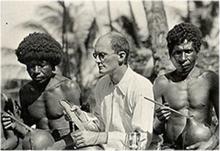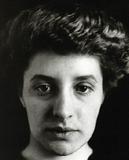
Bronislaw Malinowski, Triobriand Islands |

Jadwiga Jaczewska,1913 |
Witkacy and Malinowski (1884-1942), friends since childhood, are on a train heading to Toowoomba. After the suicide of Witkacy’s lover, Jadwiga Janczewska (a ghostly presence in the film), Malinowski persuaded the distraught writer to come with him to Australia and on to Papua New Guinea. In later years, Witkacy conducted séances in an attempt to reach Jadwiga—a clue to the significance of the film’s title.
On the trip, news of Russia’s invasion of the Polish part of the Austro-Hungarian empire causes tensions over whether or not return home. It’s impossible for Malinowski, whose response infuriates Witkacy. In fine performances, Tom Herman plays Witkacy with a neurotic intensity against the guarded restraint of Matej Busic’s Malinowski. At the same time, the train’s driver (Craig Meneaud) and his fireman (Richard Hilliar) —both in love with the same woman—conduct a funny, highflown discussion about time and relativity (taken from a 1923 Witkacy play, Crazy Locomotive) while pushing the machine to excessive speeds. At the beginning of the film we see the aftermath of a train accident, towards the end the crash, or do we? In an email exchange I asked Gillies about the film’s sources and his stylistic choices.
Witkacy & Malinowski Part 1
Witkacy & Malinowski Part 2
What inspired you to take up the Witkacy-Malinowski story?
Witkacy and Malinowski were close friends whose relationship ended tumultuously in Toowoomba, Queensland. They represent two archetypal potentialities, antagonistic but complementary. Malinowski put it rather grandly in his diary, that their split in Australia at the beginning of WW1 was, “like Wagner splitting with Nietzsche.” Their time in Australia was seminal for them personally, but also for their disciplines: the proto-performance artist and painter Witkacy as an inventor of contemporary theatre and Malinowski as a ‘father’ of contemporary anthropology. The two modernists rubbed up against indigenous cultures and colonial society in this new modern world at the edge of empire, altering their work in profound ways.
The story is also the end of the love story between two men and a conflict between materialist and metaphysical thinking, science and art. Everything in this work is based upon or developed from something that was reported or recorded. When I do change and invent, I do so to retain an underlying meaning or image or to extend the metaphor or idea. Also the possibility of linking Toowoomba and St Petersburg in the same sentence could not be ignored, it had to be done!
What role have Poland and Polish artists played in the film’s development?
The Polish-Australian actor and theatre director Lech Mackiewicz was consulting producer and one of the translators of my text and Witkacy’s texts from Polish and French, including a new translation of Crazy Locomotive. Lech’s contribution was absolutely essential to the development of this project.
In Warsaw I met Witkacy’s great-niece Agnieszka Zawadowska who, in a sense, gave me the ‘permission’ I needed to create this work. This experience is so different from what happens with the Beckett estate. In Zakopane I shot part of the snow scene close to where Witkacy and Malinowski would have played as children, and the rest in the Kosciusko National Park much closer to home, as this is also a work about absurd spatial dislocation.
The film was invited to screen at the Grotowski Institute in Wroclaw and also via the Museum of Middle Pomerania in Slupsk, which has the largest collection of Witkacy’s portrait paintings in Poland as well as examples of his Australian landscape pastels.
Complete interview available just here
Sydney Film Festival website & Tickets
culture.pl/en/article/bronislaw-malinowski-anthropologist-in-the-field
culture.pl/en/article/an-alternative-biography-of-witkacy

Jadwiga Jaczewska, fiancee, 1913. source: www.witkacy.org |
| 

